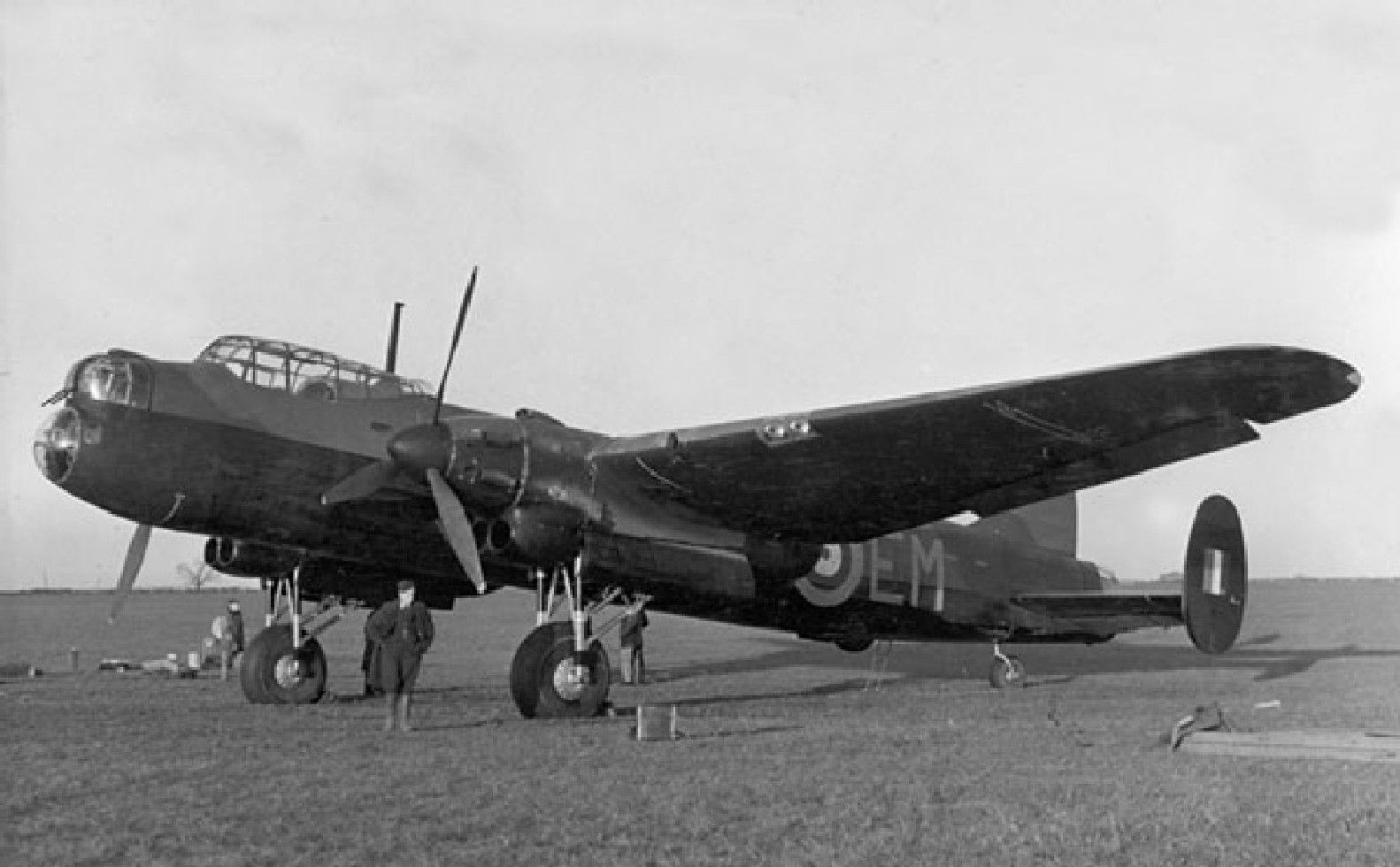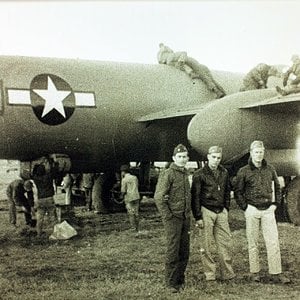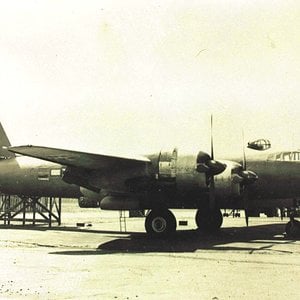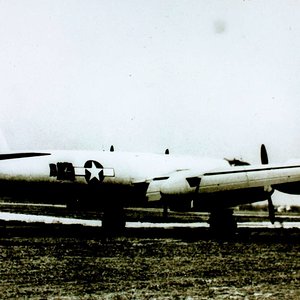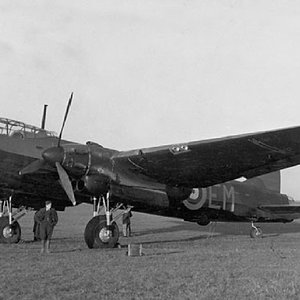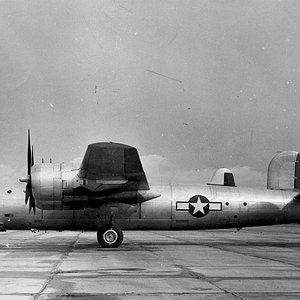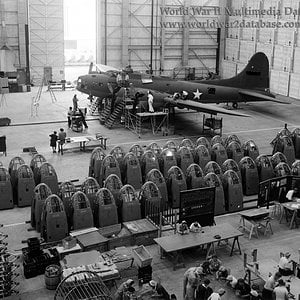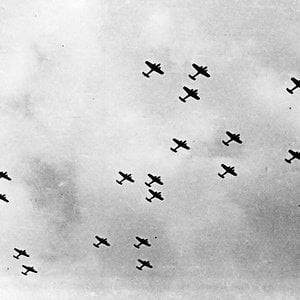Navigation
Install the app
How to install the app on iOS
Follow along with the video below to see how to install our site as a web app on your home screen.
Note: This feature may not be available in some browsers.
More options
Design
The forward section of a Manchester Mark I at Waddington, Lincolnshire, showing the nose with the bomb-aimer's window, the forward gun-turret and the cockpit, September 1941
The Avro Manchester was designed with great consideration for ease of manufacture and repair.[8] The fuselage of the aircraft comprised longitudinal stringers or longerons throughout, over which an external skin of aluminium alloy flush-riveted for a smooth external surface.[8] The wings were of a two spar construction, the internal ribs being made out of aluminium alloys; fuel was contained with several self-sealing fuel tanks within the wings.[9] The tail shared a similar construction to the wing, featuring a twin fin-and-rudder configuration that provided good vision for the dorsal gunner.
The cockpit housed the pilot and fighting controller's position underneath the canopy, as such these two crew members were provided with all-round vision. The navigator was seated aft of the fighting controller and the position included an astrodome for use of a sextant.[10] The bomb aimer's station was housed inside the aircraft's nose, beneath the forward turret and bomb aiming was conducted using optical sights housed in this compartment
The aircraft's undercarriage was entirely retractable via hydraulic systems or in emergency a backup air system.[8] The doors to the bomb bay were also operated by these systems, an additional safety measure was installed to ensure that the bombs could not be dropped if the doors were shut. The bombs were housed on bomb racks inside the internal bomb bay.
Vulnerable parts of the aircraft were armoured; the pilot had additional armour and bullet-proof glass and an armoured bulkhead was to the rear of the navigator's position. The Manchester featured three hydraulically operated turrets, located in the nose, rear and mid-upper fuselage. Access to all crew stations was provided by a walkway and crew positions had nearby escape hatches.
The Manchester was powered by a pair of Vulture engines; in service these proved to be extremely unreliable. Aviation author Jon Lake stated of the Vulture: "The engine made the Manchester mainly notable for its unreliability, poor performance, and general inadequacy to the task at hand" and attributed the aircraft's poor service record to the engine troubles.
I was one of the six original pilots to have flown with the first Manchester squadron. That was a disaster. The aircraft itself, the airframe, had many shortcomings in equipment in the beginning, but as we found out Avro were excellent in doing modifications and re-equipping the aeroplane. The engines never were and never did become reliable. They did not give enough power for the aeroplane, so we ended up with two extremely unreliable 1,750 hp engines having to haul a 50,000-pound aircraft. We should really have had 2,500 hp engines. You felt that if you'd lost one, that was it, you weren't coming home. It didn't matter if you feathered the propeller or not. There was only one way you went and that was down. I have seen an aircraft doing a run up on the ground and have two pistons come right out through the side of the engine. The original bearings were made without any silver as an economy measure, so they weren't hard enough. The bearings would collapse the connecting rod and the piston would fling out through the side of the engine and bang! Your engine just destroyed itself
The forward section of a Manchester Mark I at Waddington, Lincolnshire, showing the nose with the bomb-aimer's window, the forward gun-turret and the cockpit, September 1941
The Avro Manchester was designed with great consideration for ease of manufacture and repair.[8] The fuselage of the aircraft comprised longitudinal stringers or longerons throughout, over which an external skin of aluminium alloy flush-riveted for a smooth external surface.[8] The wings were of a two spar construction, the internal ribs being made out of aluminium alloys; fuel was contained with several self-sealing fuel tanks within the wings.[9] The tail shared a similar construction to the wing, featuring a twin fin-and-rudder configuration that provided good vision for the dorsal gunner.
The cockpit housed the pilot and fighting controller's position underneath the canopy, as such these two crew members were provided with all-round vision. The navigator was seated aft of the fighting controller and the position included an astrodome for use of a sextant.[10] The bomb aimer's station was housed inside the aircraft's nose, beneath the forward turret and bomb aiming was conducted using optical sights housed in this compartment
The aircraft's undercarriage was entirely retractable via hydraulic systems or in emergency a backup air system.[8] The doors to the bomb bay were also operated by these systems, an additional safety measure was installed to ensure that the bombs could not be dropped if the doors were shut. The bombs were housed on bomb racks inside the internal bomb bay.
Vulnerable parts of the aircraft were armoured; the pilot had additional armour and bullet-proof glass and an armoured bulkhead was to the rear of the navigator's position. The Manchester featured three hydraulically operated turrets, located in the nose, rear and mid-upper fuselage. Access to all crew stations was provided by a walkway and crew positions had nearby escape hatches.
The Manchester was powered by a pair of Vulture engines; in service these proved to be extremely unreliable. Aviation author Jon Lake stated of the Vulture: "The engine made the Manchester mainly notable for its unreliability, poor performance, and general inadequacy to the task at hand" and attributed the aircraft's poor service record to the engine troubles.
I was one of the six original pilots to have flown with the first Manchester squadron. That was a disaster. The aircraft itself, the airframe, had many shortcomings in equipment in the beginning, but as we found out Avro were excellent in doing modifications and re-equipping the aeroplane. The engines never were and never did become reliable. They did not give enough power for the aeroplane, so we ended up with two extremely unreliable 1,750 hp engines having to haul a 50,000-pound aircraft. We should really have had 2,500 hp engines. You felt that if you'd lost one, that was it, you weren't coming home. It didn't matter if you feathered the propeller or not. There was only one way you went and that was down. I have seen an aircraft doing a run up on the ground and have two pistons come right out through the side of the engine. The original bearings were made without any silver as an economy measure, so they weren't hard enough. The bearings would collapse the connecting rod and the piston would fling out through the side of the engine and bang! Your engine just destroyed itself

